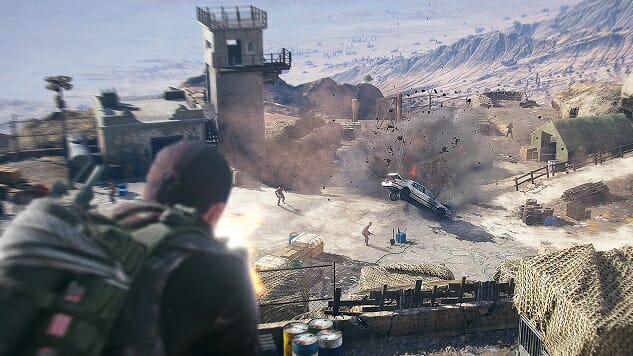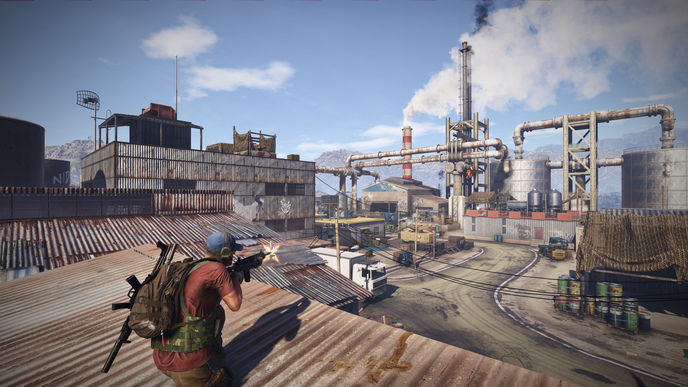Tom Clancy’s Ghost Recon Wildlands Is a Frightening Mess
Games Reviews Tom Clancy's Ghost Recon Wildlands
Everything in Tom Clancy’s Ghost Recon Wildlands aspires to the clarity and precision of a single, recurring moment: the “sync shot.” The player, as an unnamed member of the elite “Ghost” special operations unit deployed to eliminate a drug cartel that’s occupied Bolivia, lies flat on her stomach a few hundred meters from an enemy position. A single button tap sends up a little drone that notes the position of patrolling enemies. Another press of a button marks a trio of these opponents for execution by the operative’s squad mates, either artificially intelligent or controlled by another online player. At the right moment, with orange blips hovering over the cartel enemy’s heads, the sync shot is activated with a single command. Suppressed gunshots find their marks almost simultaneously. The sounds of a stick being swung through the air are followed by the dull thud of bullet on body. In an almost magical display of efficiency and technological savvy, the targets are eliminated without even a chance to react.
Each execution of the sync shot makes Wildlands feel like the hyper-precise action spectacle it clearly wants to be. Nearly invisible American operatives dispatch foreign threats with unearthly grace, cleaning out the cancer infecting another nation without allowing any of the disease to spill out into the rest of the body politic. In these moments, its fantastic version of an aggressive foreign policy that kills only those who warrant killing can seem almost potent. The “sync shot” is a tantalizing depiction of drug war ideology—one that slips a hand into the pants of a rotten, century-old mission and coaxes the descendants of its blood-soaked policies into believing that it can still work.
It is in these sync shots alone, though, that Wildlands manages to maintain control over what is an appalling celebration of violent American interventionism.
The message is tainted right from the start. An opening video explains that the player and her three Ghost squadmates have been sent to Bolivia to put an end to the Mexican Santa Blanca cartel—a group that has bribed, coerced and murdered its way to complete control of a foreign government. The Ghosts have a straightforward mission: kill or capture every member of Santa Blanca until they’ve ferreted out its leader, the ruthless, face-tattooed giant El Sueño. True to their name, the Ghosts are acting in complete secret, answering only to their CIA handler Karen Bowman. They are able to shoot, burn and destroy Bolivia with impunity just as long as they don’t purposely kill too many civilians (that earns a “Mission Failed”) on their quest to overthrow a corrupt nation.
Such a complex operation is rendered into an easily digestible format familiar to anyone who’s played a big budget sandbox game in the last decade: travel a giant map by foot or vehicle, finding new equipment and unlocking new skills, completing both side and plot-progressing story missions. The core of the game—defeating Santa Blanca—consists of simple, formulaic tasks so repetitive and numerous that at times they feel endless.
El Sueño’s captains control one of four different aspects of Santa Blanca’s operations—smuggling, production, influence and security. Each of these captains is responsible for an underboss and an additional four or five buchons or division lieutenants. To dismantle every one of the cartel’s four operational foundations, the player first has to travel to a province, cross enormous expanses to find and fight her way to intel files and, once enough of these files have been found, complete five or six missions. Overthrowing one province and killing or capturing the buchon in command feels, initially, like progress. Doing so another handful of times, completing hours upon hours of missions along the way, becomes tiring pretty quickly.
This is largely because the missions themselves present only a few variations on a single theme. The player and her fellow Ghosts (whether controlled by the computer or by real people) head to a location, send up a drone, sync shot a bunch of times and then sneak the rest of the way to an objective marker. If feeling bold, it’s possible to go in guns blazing though the characters are fragile enough that the game implicitly discourages this approach. Some missions require planting explosives on mechanical equipment or skids packed with cocaine. Others involve executing an important target or evacuating them to a nearby headquarters for interrogation. The worst missions task the player with quietly tailing a character or sneaking into bases undetected, a single misstep frustratingly resetting all progress.
What can at times be thrilling—the tension of quietly, expertly taking over a base with silenced rifles and sync shots or escaping in car or helicopter, VIP in tow, as Santa Blanca members chase like angry bees—becomes rote as it’s required again and again and again. Completing these objectives alongside online players provides some welcome unpredictability, but playing with an AI squad is more reliable. Unfortunately, it also means being able to concentrate more on Wildlands’ writing.
Fellow Ghosts Holt, Weaver and Midas are a bunch of boneheads eager to chip in regarding the task at hand. After blackmailing a corrupt politician by recording him having sex in his coastal mansion, one of the squadmates mentions that he wishes he could join in. At other times, they discuss how cocaine is made and, like an after-school special, marvel at how gross the chemicals are used in its refinement. After stealing an armored boat, one of the Ghosts talks about how he wishes he was drinking a beer, cruising around Myrtle Beach. Another says, “You think you’re twenty-two or something?”
“No, he replies. “I’m just looking to hook up with twenty-two year-olds.”
The player character isn’t any better. Finding a skill-upgrading medal: “This medal has a coca plant on it. That’s kinda cool.” Dodging bullets as a base goes on high alert: “Shitballs.” At its best, the writing is unintentionally hilarious (grabbing a bike, the protagonist flatly states “I’m on the motorcycle” like a stately toddler). More often, it approaches even the most serious subject matter with a troublingly glib tone. Mission handler Karen Bowman introduces members of Santa Blanca through bizarre, jokey slideshows that intersperse fake depictions of cartel executions or children packed into freight cars with stock photos of smiling Americans or cartoony illustrations of its cast members. When questioning captured enemies, Bowman promises to either torture them to death or send them away for life to maximum security prisons where, she’s always happy to note, they’ll be sexually assaulted by the other inmates.
This isn’t to say that real-life atrocities of Latin American drug cartels modeled in the game’s Santa Blanca are excusable in any way. But Wildlands’ engagement with the issue, despite the research evident in its many details, is as simplistic and wrong-headed as the politics that birthed the War on Drugs and lead to these very horrors. Considering everyone involved with the production and sale of illegal drugs—even the governments enmeshed in these enterprises—as villainous targets reproduces the same martial outlook that allows them to thrive. The narcos gunned down en masse by the Ghosts have been produced and empowered by American policies and imperialist politicking. Combating them is not a matter of extrajudicial capture and killing, but of long overdue reforms to the systems that make the trafficking of drugs lucrative enough to deteriorate entire nations. Harsh punishments haven’t stopped the war yet and a game that can only be won through excessive force only props up a dangerous mentality.
Wildlands’ attempts to explore the complexity of its subject matter are cursory at best. Outside of the repeated, mind-numbing killing of Bolivian and Mexican enemies the game requires, a few instances of dialogue make tired gestures toward blurring moral stakes. When asked to kidnap a potentially crooked general’s daughter, the player character is outraged at involving civilians in their fight, never mind the dozens of collateral dead that all but the most skilled players are sure to accumulate by this point. The game’s two endings are meant to convey the futility of accomplishing even so great a task as overthrowing an entire narco-state, but their messages are mixed, wrinkled with an 11th hour twist regarding the distrustfulness of even the “good Bolivians” and undermined by the dozens of hours spent coldly, automatically killing cartel members.
These endings are supposed to be bittersweet—complications of a simple drug war narrative—but they’re impossible to take seriously when players have spent an entire game inhabiting a far different role. By the time the game tries to complicate its message, Wildlands has already hammered home an understanding of American interventionism as a just and effective strategy for ending the horrors of cartel violence.
Worse is the use of Bolivia as a setting—a country that might as well not exist for Wildlands except as a beautiful countryside of gloomy forests, rolling mountains and sun-baked plains for the player to rampage across. Out of what can only be assumed to be an aversion to placing its Mexican cartel in Mexico itself, a player without a decent understanding of current Latin American politics will likely walk away from Wildlands’s chaotic depiction of Bolivia with the baseline assumption that it’s a truly frightening place—just another corrupt state tragically overrun by narcos. The game is fiction, sure, and can be set wherever it wants, but it fails to justify why, other than Bolivia’s coca fields, it would try to create this impression about a real country, distinct from its geographic neighbors in culture, politics and level of cartel-related violence.
Whatever might be said in favor of its gorgeous landscape, the lizard brain-tickling of its progression systems and utility as a focal point for online hangouts with friends, Wildlands makes these almost impossible to see through the thick miasma of its real-world implications. This is a game that doesn’t seem to care at all about the very real horrors of modern Latin American history—that presents a dire international problem as something that can be solved through the clean precision of four American badasses pulling off sync shots. Whether out of neglect, a lack of understanding or a deep callousness, it turns the suffering of the people who right now live under vicious cartels into a playground for a forgettable sandbox shooter. Its audience needs either a willful ignorance of—or a disturbing outlook on—the world around them to be able to play Wildlands without a deep sense of unease.
Tom Clancy’s Ghost Recon Wildlands was developed by Ubisoft Paris and published by Ubisoft. Our review is based on the PlayStation 4 version. It is also available for Xbox One and PC.
Reid McCarter is a writer and editor based in Toronto whose work has appeared at Kill Screen and Playboy. He is the co-editor of SHOOTER (a compilation of critical essays on the shooter genre), edits Bullet Points Monthly, co-hosts the Bullet Points podcast and tweets @reidmccarter.

